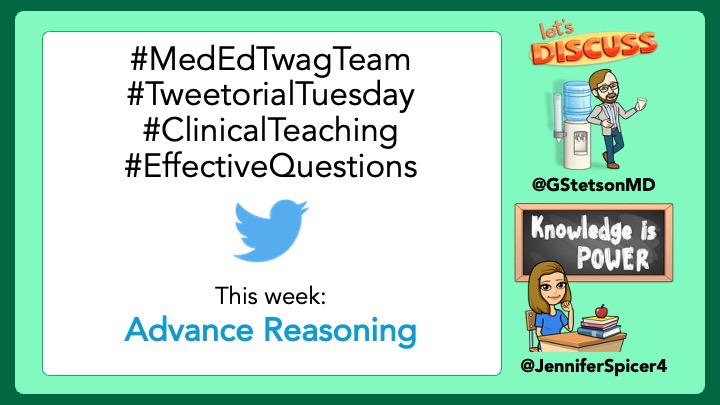
1/ Welcome back to #TweetorialTuesday with the #MedEdTwagTeam!
We are in our #EffectiveQuestions series.
Thanks for joining us, #MedTwitter, #MedEd, & #MedStudentTwitter Friends!
We are in our #EffectiveQuestions series.
Thanks for joining us, #MedTwitter, #MedEd, & #MedStudentTwitter Friends!

2/ Today is Week 2 out of 7 in this series.
Today, we will be covering some general rules about how to ask questions in the clinical learning environment.
Today, we will be covering some general rules about how to ask questions in the clinical learning environment.

3/ These are the 8 rules I personally follow. We will get into each one in this thread.
Here are some great papers for more background:
pubmed.ncbi.nlm.nih.gov/32297833/
pubmed.ncbi.nlm.nih.gov/33394663/
pubmed.ncbi.nlm.nih.gov/27541066/
Here are some great papers for more background:
pubmed.ncbi.nlm.nih.gov/32297833/
pubmed.ncbi.nlm.nih.gov/33394663/
pubmed.ncbi.nlm.nih.gov/27541066/

4/ As with all parts of learning in the clinical environment, everything goes smoother when expectations are clear and the curriculum is transparent.
Let learners know that questions are a tool you use to teach, and that they should be ready to participate.
Let learners know that questions are a tool you use to teach, and that they should be ready to participate.
5/ However, you must not use their answer in their evaluations. Make it explicit when setting expectations that you won’t.
This is key to getting full participation. Otherwise, you’ll have learners worrying more about performance than growth.
This is key to getting full participation. Otherwise, you’ll have learners worrying more about performance than growth.
6/ Along those same lines, saying ”I don’t know” needs to be an okay practice, even encouraged.
This promotes trust, patient safety, and the growth mindset when the learner goes on to fill the knowledge gap.
Right, @DxRxEdu & @rabihmgeha?
This promotes trust, patient safety, and the growth mindset when the learner goes on to fill the knowledge gap.
Right, @DxRxEdu & @rabihmgeha?
7/ You need to know why you are asking a question.
🙏 to: @SonjaRaaum @buckeye_sanjay @LiangRhea @GIMaPreceptor @SonoSamMD & @alvinseattle for sharing their reasons last week.
If you don’t know the reason, you’re probably about to ask a bad question. 👇 are some of my reasons:
🙏 to: @SonjaRaaum @buckeye_sanjay @LiangRhea @GIMaPreceptor @SonoSamMD & @alvinseattle for sharing their reasons last week.
If you don’t know the reason, you’re probably about to ask a bad question. 👇 are some of my reasons:

8/ Don’t interrupt your trainees.
We are trying to create a psychologically safe environment.
Cutting someone off who is sharing their thoughts in front of a group can sting. Bad.
Give them the chance to finish.
We are trying to create a psychologically safe environment.
Cutting someone off who is sharing their thoughts in front of a group can sting. Bad.
Give them the chance to finish.
9/ Give your learners time to answer your questions.
If your questions take thought (and they should), allow time for thinking. 5 seconds MINIMUM.
Learn to revel in the silence!
If your questions take thought (and they should), allow time for thinking. 5 seconds MINIMUM.
Learn to revel in the silence!
10/ Unless, of course, you are getting quizzical looks back. Perhaps, you have asked a “bad question” (more on this next week).
In which case, just apologize, and make your teaching point.
Learners LOVE this. It shows you care, and that you are fallible.
In which case, just apologize, and make your teaching point.
Learners LOVE this. It shows you care, and that you are fallible.

11/ Correct incorrect answers. You don’t want your efforts to create a psychologically safe learning environment to inhibit actual learning.
Praise learners’ efforts and engagement, but, gently and clearly, correct any misconceptions.
Praise learners’ efforts and engagement, but, gently and clearly, correct any misconceptions.
12/ These were our 8 general rules to asking #EffectiveQuestions.
If there are other guidelines you use, or you have any thoughts, please, comment and share with us all!
If there are other guidelines you use, or you have any thoughts, please, comment and share with us all!

13/ Alright, friends! Thanks for joining us.
Before we get into some of my favorite reasons and ways to ask questions, we need to talk about "bad questions." That's next week!
Make sure to follow: @GStetsonMD, @JenniferSpicer4 & @MedEdTwagTeam
Until then!
Before we get into some of my favorite reasons and ways to ask questions, we need to talk about "bad questions." That's next week!
Make sure to follow: @GStetsonMD, @JenniferSpicer4 & @MedEdTwagTeam
Until then!

• • •
Missing some Tweet in this thread? You can try to
force a refresh





















